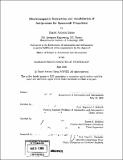Electromagnetic extraction and annihilation of antiprotons for spacecraft propulsion
Author(s)
Zayas, Daniel Antonio
DownloadFull printable version (20.43Mb)
Other Contributors
Massachusetts Institute of Technology. Dept. of Aeronautics and Astronautics.
Advisor
Raymond J. Sedwick and James A. Bickford.
Terms of use
Metadata
Show full item recordAbstract
A novel concept for the extraction and long-term trapping of antiprotons from planetary magnetospheres is developed. The excitation via rotating magnetic field of an electron population within a distributed neutral plasma is shown to produce a large-scale magnetic field approximating a dipole with r-² or slower decay. These shallow field gradients are, in turn, found to suppress the natural tendency of the magnetic dipole field to shield against incident particle fluxes. Particle transport and plasma interaction models are developed and used to compare collection performance against various electrostatic and magnetostatic collection systems. Baseline system architectures are presented, and antiproton collection rates on the order of nanograms per day are estimated, far exceeding current Earth-based production rates. To demonstrate the performance potential of antiproton fuels for spacecraft propulsion, a modified rocket equation with relativistic corrections and variable mass-energy conversion efficiency is derived. Antimatter engines operating via the catalysis of nuclear fission in a fissile material by antiprotons are found to be three to four (3 - 4) times more efficient than traditional proton-antiproton annihilation or "beam-core" engines, and vastly more efficient than conventional chemical and electric propulsion systems. Baseline architectures for various missions are presented.
Description
Thesis (S.M.)--Massachusetts Institute of Technology, Dept. of Aeronautics and Astronautics, 2008. Includes bibliographical references (p. 85-87).
Date issued
2008Department
Massachusetts Institute of Technology. Department of Aeronautics and AstronauticsPublisher
Massachusetts Institute of Technology
Keywords
Aeronautics and Astronautics.